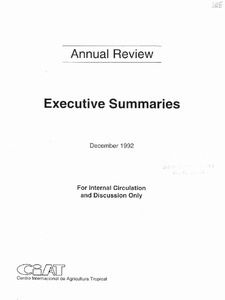An agroecological zonation for Uganda: methodology and spatial information
Animal genetics training resources: Capacity building for sustainable use of animal genetic resources in developing countries
This training resource is presented in five modules. 1) Global perspectives on animal genetic resources for sustainable agriculture and food production in the tropics. This module provides some insight into the need for better use of animal genetic resources (AnGR) in the context of projected demand for food in developing countries until 2020. 2) Improving our knowledge of tropical indigenous animal genetic resources.
Annual Report 2011: Groundwork for success
2011 was the first year of operation of the CGIAR Research Program on Climate Change, Agriculture and Food Security (CCAFS). CCAFS brings together the work of all 15 international Centres in the CGIAR, and is a joint programme between the CGIAR and the Earth System Science Partnership (ESSP). 2011 was a start-up year in terms of introducing a new way of working across Centres, but it was also a year of considerable research effort. Work was initiated in the field at many sites, and baseline surveys were completed in three regions on two continents.
Annual Review : Executive Summaries 1992
Assessing complex interactions between human and agro-ecosystem using satellite information. A case study in Katuk Odeyo, Western Kenya.
The objective of this study is to integrate socioeconomic, biophysical, and remote-sensing information to enhance the understanding of climate change, agriculture and food security within and between CCAFS sites. The purpose is to assess the agricultural production system in the CCAFS site Katuk Odeyo, Nyando (Western Kenya) to explore potential indicators that can be long-term monitored. Ecosystem health determines energy supply and demand by sustaining the productive capacity of the landscape.
Assessing the impact of integrated natural resource management: Challenges and experiences
Assessing the impact of integrated natural resource management (INRM) research poses a challenge to scientists. The complexity of INRM interventions requires a more holistic approach to impact assessment, beyond the plot and farm levels and beyond traditional analysis of economic returns. Impact assessment for INRM combines the traditional "what" and "where" factors of economic and environmental priorities with newer "who" and "how" aspects of social actors and institutions. This paper presents an analytical framework and methodology for assessing the impact of INRM.
Assisting community management of groundwater: irrigator attitudes in two watersheds in Rajasthan and Gujarat, India
The absence of either state regulations or markets to coordinate the operation of individual wells has focussed attention on community level institutions as the primary loci for sustainable groundwater management in Rajasthan and Gujarat, India. The reported research relied on theoretical propositions that livelihood strategies, groundwater management and the propensity to cooperate are associated with the attitudinal orientations of well owners in the Meghraj and Dharta watersheds, located in Gujarat and Rajasthan respectively.
Assessment of skimming well performance in Punjab, Pakistan by groundwater simulation modelling
Baseline characterization of production and markets, technologies and preferences, and livelihoods of smallholder farmers and communities affected by HIV/AIDS in Swaziland
Beyond zero deforestation in the Brazilian Amazon Progress and remaining challenges to sustainable cattle intensification
Key Messages
• A governance approach, combining public policy and private initiatives was effective in slowing down deforestation, but
was unable to support a transition to more sustainable production systems.
• New technical intensification models must be identified for low-productivity systems in degraded lands, adapted to the
biophysical and sociotechnical conditions of the Amazonian landscapes.
• Multiple constraints inhibit progress toward sustainable intensification of cattle ranching, and reversing them requires that









